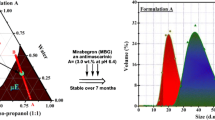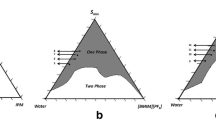Abstract
The microemulsion composed of oleic acid, phosphate buffer, ethanol, and Tween (20, 40, 60, and 80) has been investigated in the presence of antitubercular drugs of extremely different solubilities, viz. isoniazid (INH), pyrazinamide (PZA), and rifampicin (RIF). The phase behavior showing the realm of existence of microemulsion has been delineated at constant surfactant/co-surfactant ratio (K m = 0.55) with maximum isotropic region resulting in the case of Tween 80. The changes in the microstructure of Tween 80-based microemulsion in the presence of anti-TB drugs have been established using conductivty (σ) and viscosity (η) behavior. The optical microscopic images of the system help in understanding the effect of dilution and presence of drug on the structure of microemulsion. Partition coefficient, particle size analysis, and spectroscopic studies (UV–visible, Fourier transform infrared, and 1H NMR) have been performed to evaluate the location of a drug in the colloidal formulation. To compare the release of RIF, PZA, and INH from Tween 80 formulation, the dissolution studies have been carried out. It shows that the release of drugs follow the order INH>PZA>RIF. The kinetics of the release of drug has been analyzed using the Korsmeyer and Peppas equation. The results have given a fair success to predict that the release of PZA and INH from Tween 80 microemulsion is non-Fickian, whereas RIF is found to follow a Fickian mechanism.








Similar content being viewed by others
References
Chan J, El Maghraby GMM, Craig JP, Alany RG. Phase transition water-in-oil microemulsions as ocular drug delivery systems: in vitro and in vivo evaluation. Int J Pharm. 2007;328:65–71.
Formariz TP, Chiavacci LA, Sarmento VHV, Franzini CM, Silva Jr AA, Scarpa MV, et al. Structural changes of biocompatible neutral microemulsions stabilized by mixed surfactant containing soya phosphatidylcholine and their relationship with doxorubicin release. Colloids Surf B. 2008;63:287–95.
Constantinides PP. Lipid microemulsion for improving drug dissolution and oral absorption: physical and biopharmaceutical aspects. Pharm Res. 1995;12:1561–72.
Kummaro TR, Gurleym B, Khan MA, Reddy IK. Self-emulsifying drug delivery systems (SEMDDS) of co-enzyme Q10: formulation development and bioavailability assessment. Int J Pharm. 2001;212:233–46.
Nornoo AO, Osborne DW, Chow DSL. Cremophor-free intravenous microemulsions for paclitaxelI: formulation, cytotoxicity and hemolysis. Int J Pharm. 2008;349:108–16.
Narang AS, Delmarre D, Gao D. Stable drug encapsulation in micelles and microemulsions. Int J Pharm. 2007;345:9–25.
Winsor PA. Hydrotropy, solubilisation and related emulsification processes. J Chem Soc Faraday Trans. 1948;44(1):376–98.
Israelachvili JN, Mitchell DJ, Ninham BW. Theory of self-assembly of hydrocarbon amphiphiles into micelles and bilayers. J Chem Soc Faraday Trans II. 1976;72:1525–67.
Kumar P, Mittal KL. Handbook of microemulsion: science and technology. New York: Marcel Dekker; 1999.
Lopez A, Linares F, Cortell C, Herraez M. Comparative enhancer effects of Span 20® with Tween 20® and Azone® on the in vitro percutaneous penetration of compounds with different lipophilicities. Int J Pharm. 2000;202:133–40.
Fang JY, Yu SY, Wu PC, Huang YB, Tsai YH. In vitro skin permeation of estradiol from various proniosome formulations. Int J Pharm. 2001;215:91–9.
Kibbe AH. Handbook of pharmaceutical excipients. 3rd ed. London: Pharmaceutical Press; 2000.
Lawerence MJ, Rees GD. Microemulsion based media as novel drug delivery systems. Adv Drug Deliv Rev. 2000;45:89–121.
Florence AT, Attwood D. Physicochemical principles of pharmacy. 3rd ed. London: Macmillan; 1998.
Kreuter J. Colloidal drug delivery systems. New York: Marcel Dekker; 1994. p. 219–342.
Podlogar F, Gašperlin M, Tomšič M, Jamnik A, Bešter-Rogač M. Structural characterization of water–Tween 40®–Imwitor 308®–isopropyl myristate using different experimental methods. Int J Pharm. 2004;276:115–28.
Lee JP, Langer R, Shastri VP. Novel microemulsion enchancer formulation for simultaneous transdermal delivery of hydrophilic and hydrophobic drugs. Pharm Res. 2003;20:264–9.
Podlogar F, Rogac MB, Gasperlin M. The effect of internal structure of selected water–Tween 40®–Imwitor 308®–IPM microemulsion on ketoprofene release. Int J Pharm. 2005;302:68.
Guo R, Qian S, Zhu J, Qian J. The release of cephanone in CTAB/n-C5H11OH/H2O system. Colloid Polym Sci. 2006;284:468–74.
Du Toit LC, Pillay V, Danckwerts MP. Tuberculosis chemotherapy: current drug delivery approaches. Resp Res. 2006;7:118–36.
Mehta SK, Kaur G, Bhasin KK. Analysis of Tween based microemulsion in the presence of TB drug rifampicin. Colloid Surf B. 2007;60:95–104.
Mehta SK, Kaur G, Bhasin KK. Incorporation of antitubercular drug isoniazid in pharmaceutically accepted microemulsion: effect on microstructure and physical parameters. Pharm Res. 2008;25:226–37.
Lagourette B, Peyrelasse J, Boned C, Clausse M. Percolative conduction in microemulsion type systems. Nature. 1979;281:60–2.
Mehta SK, Bala K. Volumetric and transport properties in microemulsions and the point of view of percolation theory. Phys Rev E. 1995;51:5732–7.
Bennett KE, Hatfield JC, Davis HT, Macosko CW, Seriven LE. Viscosity and conductivity of microemulsions. In: Robb ID, editor. Microemulsions. New York: Plenum; 1982. pp. 65–84.
Mitra RK, Paul BK. Physicochemical investigations of microemulsification of eucalyptus oil and water using mixed surfactants (AOT+Brij35) and butanol. J Colloid Inter Sci. 2005;283:565–77.
Kasim NA, Whitehouse M, Ramachandran C, Bermejo M, Lennerna H, Hussain AS, et al. Molecular properties of WHO essential drugs and provisional biopharmaceutical classification. Mol Pharm. 2004;1:85–96.
Aliotta F, Migliardo P, Donato DI, Liveri VT, Bardez E, Larry B. Local hydration effects in reversed micellar aggregation. Progr Colloid Polym Sci. 1992;89:258–62.
Arcoleo V, Goffredi M, Liveri VT. Physicochemical characterization of copper(II) bis(2-ethylhexyl) sulfosuccinate reversed micelles. J Colloid Int Sci. 1998;198:216–23.
El-Laithy HM. Preparation and physicochemical characterization of dioctyl sodium dulfosuccinate (Aersol OT) microemulsion for oral drug delivery. AAPS PharmSci Tech. 2003;4(Article 11):1–10.
Wakiyama N, Juni K, Nakano M. Preparation and evaluation in vitro of polylactic acid microspheres containing local anesthetics. Chem Pharm Bull. 1981;29:3363–8.
Zhang L, Sun X, Zhang ZR. An investigation on liver-targeting microemulsions of norcantharidin. Drug Deliv. 2005;12:289–95.
Washington C. Drug release from microdisperse systems: a critical review. Int J Pharm. 1990;58:1–12.
Acknowledgments
S.K.M. is thankful to DST India for financial assistance. GK is grateful to CSIR for Senior Research Fellowship. The authors are thankful to RSIC, Panjab University, Chandigarh for providing optical images using Leica microscope DM 3000 (Germany).
Author information
Authors and Affiliations
Corresponding author
Rights and permissions
About this article
Cite this article
Mehta, S.K., Kaur, G. & Bhasin, K.K. Tween-Embedded Microemulsions—Physicochemical and Spectroscopic Analysis for Antitubercular Drugs. AAPS PharmSciTech 11, 143–153 (2010). https://doi.org/10.1208/s12249-009-9356-5
Received:
Accepted:
Published:
Issue Date:
DOI: https://doi.org/10.1208/s12249-009-9356-5




